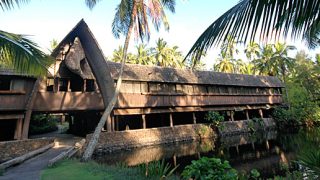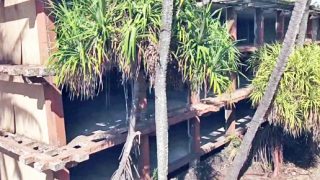Urgent warnings are sounding from Kauai this week. Officials are calling the coconut rhinoceros beetle infestation an “all-hands-on-deck” emergency, and with good reason. What is unfolding now could fundamentally change the face of the Garden Isle — and the time to act is slipping away fast.
The coconut rhinoceros beetle, a devastating invasive species, has now been confirmed across large areas of Kauai from Haena on the north shore to Waimea on the West Side. Experts and residents fear that Kauai’s iconic coconut palms, a beloved part of the island’s scenery and culture, could be wiped out if the outbreak is not quickly contained.


How the beetles on Kauai destroy from within.
Coconut rhinoceros beetles burrow into the crowns of palm trees, destroying them from the inside out. By the time damage is visible — often when fronds start dying or falling off — the beetles have already been attacking the tree for six to nine months. Experts warn that even healthy-looking trees may already be compromised.
A recent green waste pile on Oahu produced over 900 beetles in just one hour of searching. One such breeding site can generate thousands more beetles in a single season, compounding the infestation at an alarming rate. “If you have palm trees, it’s time to kiss them goodbye,” said one frustrated resident reacting to the spread online. Another warned, “Once they are here in force, it’s almost impossible to get them back under control.”
Lessons from other islands.
The beetle was first detected in Hawaii at Joint Base Pearl Harbor-Hickam more than a decade ago. Despite years of efforts, it has since spread throughout much of Oahu.
On Guam, the story is even worse — coconut palms, once abundant, were nearly wiped out after the beetle was not taken seriously in the early stages.
Other Pacific Islands are also threatened. In Tahiti, authorities require disinsection (spraying for insects) on all arriving aircraft to help prevent infestation. (At this time, there is no confirmed established population of coconut rhinoceros beetles in Tahiti.)
Kauai’s urgent fight to save its palms.
Kauai Council Member Fern Holland is leading local efforts. She has pushed for greater funding and national attention, including lobbying in Washington, D.C. Despite these efforts, resources remain stretched thin. Counties typically lack the specialized staff, equipment, and funding needed to respond to a biosecurity threat of this scope.
How the fight targets mulch and breeding grounds.
The beetles lay their eggs in decomposing green waste, making mulch piles ideal breeding grounds. Residents are being urged to turn mulch frequently and expose it to sunlight, which can kill larvae before they mature. Specialized netting that can trap adult beetles is difficult to source due to strict regulations on fishing nets.
Some creative measures are already being deployed. Detection dogs trained to sniff out beetle larvae have been used on Oahu and the Big Island, offering some added hope of intervention. Still, given the beetle’s explosive reproductive rate, experts say Kauai’s window to act is rapidly closing.
“It’s heartbreaking. Palms are part of what makes Kauai feel like home,” one resident told us, reacting to early signs of tree loss and asking that we write about it to help raise awareness.
What is at risk.
The loss of coconut palms would not only damage the island’s natural beauty but could also impact parks, beaches, resorts, and beloved local gathering spots. Coconut trees are tightly woven into Kauai’s identity — from the shores of Hanalei to the beaches of Poipu — and their disappearance would leave a visible scar.
What visitors should watch for.
Everyone on the island is encouraged to report any sightings as soon as possible. Early detection remains the best hope to protect Kauai’s trees before the beetles become unstoppable.
If you see signs of coconut rhinoceros beetles or suspect an infestation, visit Kauai Coconut Rhinoceros Beetle Response for more information and reporting tools.
Get Breaking Hawaii Travel News





My wife and I have visited Kauai primarily multiple times. We’ve seen airfares more than doubled, excessive restaurant prices and grid lock traffic.
I can’t blame locals for having mixed feelings about tourist. If l had to fight the traffic every day just to go to work, I would be happy.
In large part the politicians are to blame for not improving the roads before they reach gridlock.
We love Kauai! We have met so many locals and have enjoyed feeling the aloha spirit. However, Kauai has gotten to be cost prohibitive. Our love for Kauai will continue but it’s become unaffordable.
Nothing to do with Palm Trees but us residents of Northern Arizona like me face similar issues with Bark Beetles and Scale Bug Beetles. Bark Beetles bore into and kill Ponderosa Pines in the National Forest and on private properties. Scale Bug Beetles are sap-sucking pests that attack various central highlands trees, including our pinon pines. It’s a never ending battle with these pests to save our pines.
Finally the coconut rhinoceros beetle has come back to Hawaii. Greed and karma has made a full circle in Hawaii. Since these insects are not native to Hawaii they could be considered tourists. Whats Hawaii without palm trees? No shade except in buildings and hotels. See what ya get when you take advantage of tourists? Karma,Karma, and more karma.
Is there anyone in the know who can elaborate on these pests? Do they attack Every variety of coconut trees, even low Samoans?
With public pensions, salaries and cronyism there will never be enough resources to deal with this.
If all the palm trees go, the parakeets will be greatly affected. We love the evening “bird show” as the parakeets come in to roost in the Poipu area, but we know that those birds are invasive and very damaging to the crops. We would be very sad to see them go but from an environmental aspect, it would be one upside to loosing the palm trees. Don’t get me wrong, I understand that the loss of the palm trees would be catastrophic and I do not want to loose them. I can’t imagine Kauai without them.
Hmmm …how convenient for the hight rise developers wanting to outsmart Kauai’s ordinance that no building can be higher than a coconut palm tree. Destroy the palm trees and build high rise hotels! Disgusting greed. Time for clarification on building laws. No building higher than 4 stories. Kauai does not want to look like Waikiki Oahu!
I’d be ok with high rises if they were for Kauai families. It may be the only affordable way considering the cost of land.
Or we can just keep waiting for the perma government to keep solving the problem.
We have numerous co-cos on our north shore property. They grow like weeds, and while pleasant to look at, are a PITA to keep “pleasant looking” i.e., trim once or twice a year, not to mention all the falling nuts that are lethal. Our mow & blow guy won’t get too close to a tree trunk when it’s fully loaded up there – and I don’t blame him. I’ve had once incidence of crown rot – presumably these beetles, but I never saw any of them. We took it down with a chain saw. That one was growing too close to the house anyway. Want a new co-co tree? Just bury a fresh nut up to the crown before a rainy period.
If they don’t get control of this invasive pest, there will no longer be a “Royal Coconut Coast.” Much of the scenic beauty of Kauai will be lost. The tall palms swaying on the island always make me feel like I am in Hawaii.